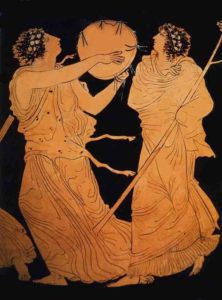In electronic music, rhythm is given by different elements that are integrated into the composition, such as multiple instruments recorded and modified with a sampler, MIDI controllers, or added directly through a drum machine, among other possibilities. With the integration of folk into electronic
and certain styles of this musical genre, percussion has found its place in the scene, especially in certain circles where music is used as a medium for rituals and celebrations, such as ecstatic dance sessions.
It is very interesting the transversality of percussion as an instrument deeply linked to spirituality and religiosity, an element that is still alive through the years and that we tell you a little more about here.
It is said that percussion is one of the oldest instruments – if not the oldest -, having found evidence of prehistoric stones and pieces of wood that are believed to have been used for this purpose. Throughout history and across continents and civilizations, percussion and dance have been used in rituals to mimic nature and connect with it, to receive guidance and understand the mysteries of life.

When anthropologist Wolfgang Jilek was researching the frequencies of the ritual dances of the Salish culture, he discovered that the predominant frequency in the rhythm of their drums coincided with the tetha waves of the human brain, which prompted his hypothesis that this frequency would be the most effective way to enter altered states of consciousness. There are many ancient civilizations that had sacred drums to open communication with spirits and help enter a trance state. For this reason, many Native Americans have called the sound of the drum the “heartbeat of the earth”.
In many cultures, percussion had a symbolic meaning associated with rituals, as in the case of the Zinacanteca tradition, in which percussion had a role in the transitions of social life, transmission of important messages, signaling the passage of solar time and other elements of the natural world. Something similar happens with the Batá Drums (from the Yoruga – Nigerian Tambor language), which establish a link between the human being and his deities. We can see another example in the Japanese culture, in which the Taiko is played, sacred instrument that is translated literally as big drum. In the case of the Sami people, who inhabit the circumpolar regions of northern Europe and Asia, shamans use the repetitive and monotonous sound of the drum to enter into states of trance and communicate with the spirits.
In the Mapuche culture, alive in Chile, the name of the ritual drum is the kultrún, and it is the most important instrument of their culture, used by the machis for sacred purposes of connection with their deities.
In the case of the tradition of ancient Athens, it has been possible to discover through art of the time, the use of percussions in religious rituals and festivals of spiritual character such as those performed in honor of Aphrodite and Dionysus. It has been studied that the purpose of the use of these instruments was mainly to please the deities and thus invoke their goodness and help. There is also evidence that percussion instruments were used for the personal enjoyment of the participants of these rituals and festivals, to accompany dances in honor of fertility, marriage, nature and to celebrate the cycle of life and nature.
A very interesting aspect of this particular culture is that these types of ceremonies and rituals were an opportunity for women to participate in the religious life of the city, leaving their more private environment and enjoying themselves, being part of a collective event and feast. However, women also used to celebrate private festivities, inside their homes, with percussions and music, since at the time and culture it was considered that their dances could provoke male citizens.

Unlike the case of Athens, according to studies of different cultures, percussions and dance in ancient civilizations used to be reserved exclusively for women priestesses who, through these elements, invoked the divine feminine energy to transmit it to the community.
In addition to its ritual and ancestral dimension, the effect of percussions on the organism and emotional state has been studied, opening another interesting line of analysis that suggests that percussions, depending on the instrument and rhythm, can have a healing effect, helping us to enter into states of full consciousness.
If we take all this information and apply it to a musical style such as electronic, which is characterized by the reproduction of repetitive sounds that often seek to generate an emotional impact on the audience, it is extremely interesting how artists and producers have been able to reproduce sounds of instruments with so much history, electronically.
It is extremely important to reflect on the use of sacred sounds such as percussion in recreational music or outside the context for which these sounds were created. Today there is more and more awareness about respect and cultural appropriation, while globalization and social networks allow us to access infinite information often without all the context we need to understand it. Undoubtedly this leaves much room for exploration and advancement.

